Embark on a captivating journey into the realm of draft horses, where strength, resilience, and unwavering spirit converge. Different breeds of draft horses, each with its unique characteristics and historical significance, have played a pivotal role in shaping human civilization.
From the majestic Clydesdale to the gentle Suffolk Punch, discover the captivating world of these equine giants.
Their towering stature, muscular physique, and exceptional pulling power have made draft horses indispensable partners in agriculture, transportation, and modern-day endeavors. Explore their fascinating history, physical attributes, temperament, and the diverse roles they have fulfilled throughout the ages.
Breeds of Draft Horses
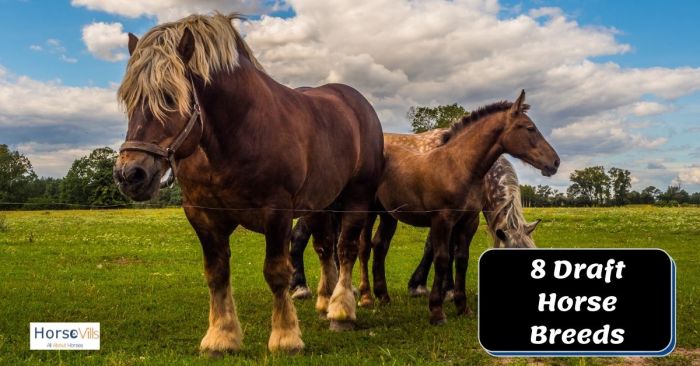
Clydesdale Horses
Clydesdale horses, originating from Scotland, are known for their distinctive appearance and impressive stature. Their towering height, often exceeding 18 hands, and robust build make them a sight to behold. Their feathering, an abundant growth of long, silky hair on the lower legs, adds to their grandeur and distinguishes them from other draft breeds.
Clydesdales possess a gentle and willing temperament, making them popular for both work and recreational activities.
Physical Attributes
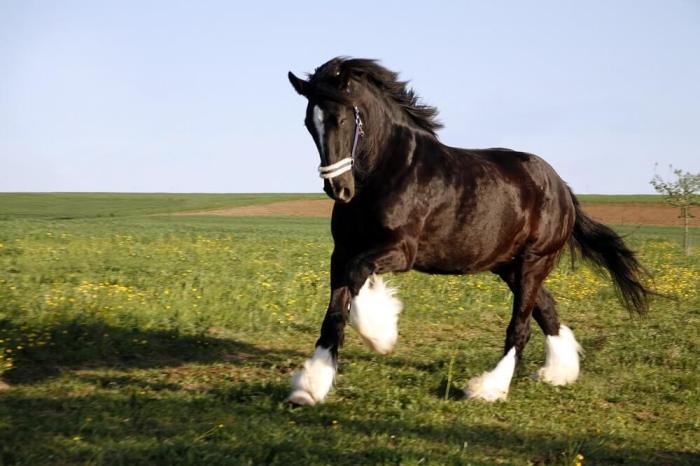
Draft horses are known for their exceptional strength and muscular build. They typically stand between 15 and 19 hands (60 to 76 inches) tall and weigh between 1,600 and 2,400 pounds. Their bodies are broad and muscular, with strong legs and hooves.
Draft horses have a variety of coat colors, including black, brown, bay, and chestnut. They may also have white markings on their faces, legs, and bodies.
Height, Weight, and Body Structure
The following table compares the height, weight, and body structure of different draft horse breeds:| Breed | Height | Weight | Body Structure ||—|—|—|—|| Clydesdale | 16-18 hands | 1,800-2,200 pounds | Muscular and powerful, with a broad chest and strong legs || Percheron | 15-17 hands | 1,600-2,000 pounds | Compact and muscular, with a well-proportioned body || Shire | 16-19 hands | 1,800-2,400 pounds | Massive and powerful, with a heavy head and legs || Belgian | 16-18 hands | 1,800-2,200 pounds | Muscular and athletic, with a strong back and hindquarters || Suffolk Punch | 15-16 hands | 1,600-1,800 pounds | Compact and muscular, with a short, powerful body |
Coat Colors and Markings
Draft horses come in a variety of coat colors, including black, brown, bay, and chestnut. They may also have white markings on their faces, legs, and bodies. Some common markings include:*
-*Blaze
A white stripe that runs down the center of the face
-
-*Star
A white spot on the forehead
-*Snip
A small white spot on the nose
-*Stocking
A white marking that covers the lower leg
-*Coronet
A white marking that surrounds the hoof
Common Health Issues and Lifespan
Draft horses are generally healthy animals, but they can be susceptible to certain health issues, such as:*
-*Laminitis
A condition that causes inflammation of the hooves
-
-*Colic
A condition that causes abdominal pain
-*Respiratory problems
Draft horses are prone to respiratory problems, such as heaves and bronchitis
-*Joint problems
Draft horses can develop joint problems, such as arthritis and navicular disease
The average lifespan of a draft horse is 20-25 years.
Temperament and Uses
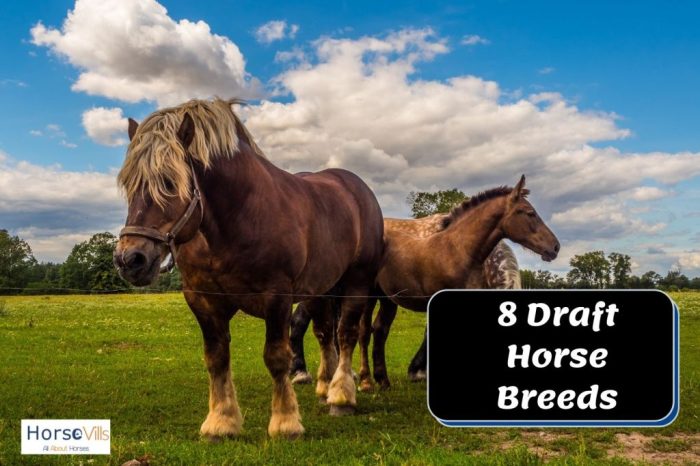
Draft horses are renowned for their gentle and hardworking nature, making them ideal partners for various tasks. Their calm and docile temperament allows them to be handled easily, even by inexperienced individuals. They possess a strong work ethic and a willingness to cooperate, making them highly trainable and reliable.
Traditional Roles
Historically, draft horses played a pivotal role in agriculture and transportation. Their immense strength and endurance enabled them to pull heavy loads, plow fields, and transport goods over long distances. They were the backbone of agricultural communities, contributing significantly to food production and economic growth.
Modern Uses, Different breeds of draft horses
While their traditional roles have diminished with mechanization, draft horses continue to find valuable uses in modern society. They are employed in forestry and logging operations, where their ability to navigate rough terrain and haul heavy logs proves invaluable. They are also used in recreation, participating in draft horse competitions, trail riding, and other equestrian activities.
Unique Abilities and Strengths
Compared to other horse breeds, draft horses possess several unique abilities and strengths. Their muscular build and powerful frames allow them to exert tremendous force, making them capable of pulling heavy loads. Their docile temperament and willingness to work make them suitable for tasks that require cooperation and patience.
Additionally, their hooves are naturally large and strong, providing excellent traction on various surfaces.
Breeding and Care
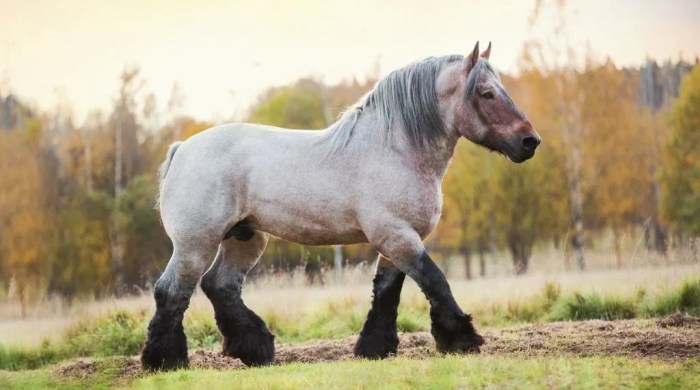
Maintaining the genetic diversity and integrity of draft horse bloodlines requires selective breeding practices. Breeders meticulously select stallions and mares with desirable traits, ensuring the preservation of specific characteristics and performance capabilities.
Nutrition
Draft horses have substantial nutritional demands due to their size and workload. A balanced diet rich in high-quality hay, grains, and supplements is crucial for maintaining their energy levels, muscle mass, and overall health.
Exercise
Regular exercise is essential for draft horses’ physical and mental well-being. Gradual increases in workload and appropriate terrain challenges help strengthen their muscles, tendons, and cardiovascular systems.
Grooming
Thorough grooming is vital for maintaining draft horses’ skin and coat health. Regular brushing, bathing, and hoof care prevent skin infections, reduce parasites, and promote overall comfort.
Veterinary Care
Specialized veterinary care is necessary for draft horses due to their unique health concerns. Regular checkups, vaccinations, and preventative measures are crucial for early detection and treatment of potential health issues.
Challenges and Rewards
Owning and caring for draft horses presents both challenges and rewards. The substantial costs associated with their upkeep, demanding physical care, and specialized veterinary needs can be daunting. However, the immense strength, loyalty, and companionship they provide make the effort worthwhile for many owners.
Draft Horse Organizations
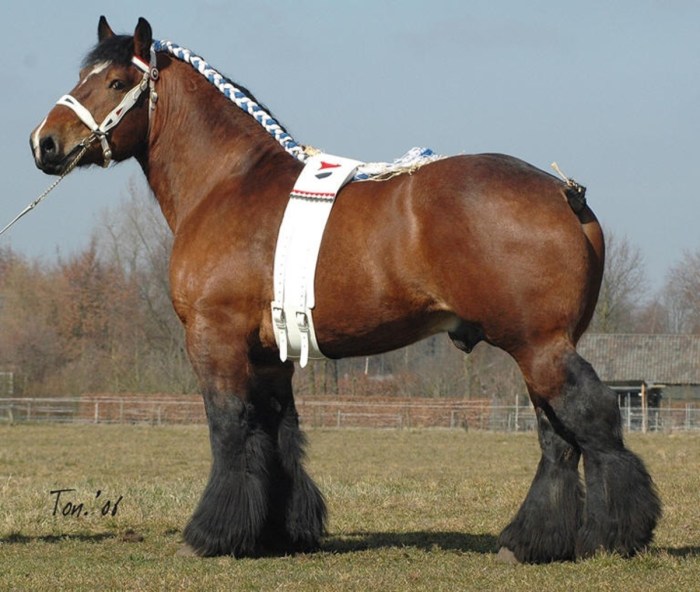
Draft horse organizations play a vital role in promoting and preserving draft horse breeds worldwide. These organizations strive to protect and enhance the genetic diversity, health, and welfare of draft horses. They also promote the use of draft horses in various activities, such as farming, forestry, and recreational driving.
Major Draft Horse Organizations
Numerous draft horse organizations exist worldwide, each with its specific focus and goals. Some of the most prominent organizations include:
The American Quarter Horse Association (AQHA)
The AQHA is the largest breed registry for Quarter Horses, a popular draft horse breed used in various disciplines, including Western riding and rodeo events.
The American Shire Horse Association (ASHA)
The ASHA promotes and preserves the Shire horse, a heavy draft breed known for its strength and versatility.
The Belgian Draft Horse Corporation of America (BDHCA)
The BDHCA is dedicated to preserving and promoting the Belgian Draft horse, a powerful and hardworking breed often used in farming and logging operations.
The Clydesdale Horse Society of North America (CHSNA)
The CHSNA supports the Clydesdale horse, a Scottish draft breed famous for its distinctive feathering and gentle temperament.
The Percheron Horse Association of America (PHAA)
The PHAA promotes and preserves the Percheron horse, a French draft breed known for its athleticism and endurance.
Role in Promoting and Preserving Draft Horse Breeds
Draft horse organizations play a crucial role in maintaining the genetic diversity and health of draft horse breeds. They establish and enforce breed standards, which help ensure the preservation of desired traits and characteristics. Organizations also maintain studbooks, which record the pedigrees and breeding history of registered horses.
This information is essential for tracking genetic diversity and preventing inbreeding.Furthermore, draft horse organizations promote the use of draft horses in various activities, such as farming, forestry, and recreational driving. They organize events, competitions, and exhibitions that showcase the versatility and capabilities of draft horses.
These events provide opportunities for breeders and owners to display their horses, promote their breeds, and educate the public about the importance of draft horses.
Events, Competitions, and Exhibitions
Draft horse organizations host a wide range of events, competitions, and exhibitions throughout the year. These events provide opportunities for breeders and owners to showcase their horses, promote their breeds, and compete for prizes and recognition.
Breed Shows
Breed shows are competitions where draft horses are judged based on their conformation, temperament, and overall appearance. Horses are evaluated against breed standards and awarded prizes based on their adherence to these standards.
Performance Competitions
Performance competitions assess the athleticism and versatility of draft horses. These competitions may include draft pulls, where horses are judged on their ability to pull heavy loads, and driving competitions, where horses are evaluated on their obedience, maneuverability, and overall performance.
Exhibitions
Exhibitions are non-competitive events that provide opportunities for breeders and owners to showcase their draft horses to the public. These events often include demonstrations of draft horse activities, such as farming, logging, and driving.By organizing these events, draft horse organizations promote the use of draft horses in various disciplines and educate the public about the importance and versatility of these breeds.
FAQ Guide: Different Breeds Of Draft Horses
What is the largest breed of draft horse?
Shire horses are generally considered the largest breed of draft horse.
What is the most common color of draft horses?
Bay, black, and gray are the most common coat colors found in draft horses.
Are draft horses good for riding?
While draft horses are primarily bred for pulling and hauling, some individuals can be trained for riding, particularly for recreational purposes.